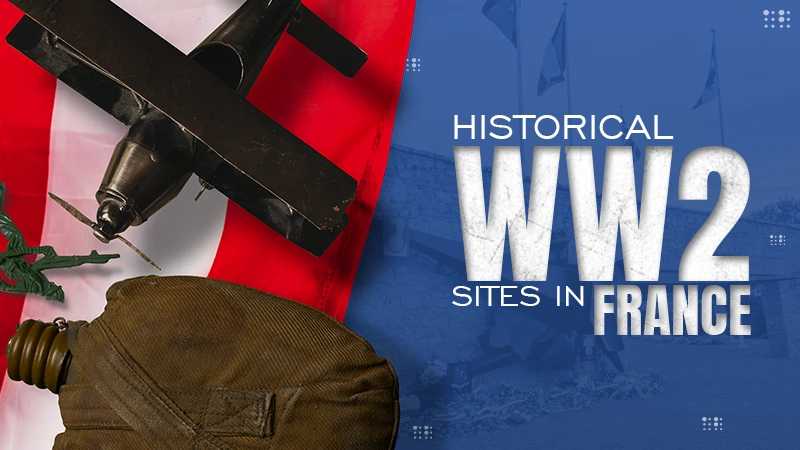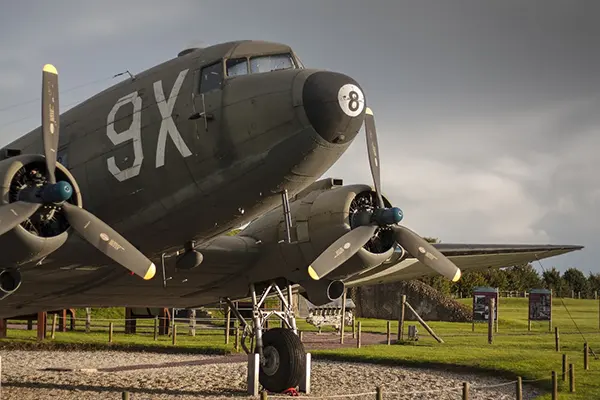
Few wars had as dramatic an impact on the world as the Second World War, which led to an untimely death for tens of millions of people. We hope to never see such large-scale destruction and despair, ever again, in the future. But we should always remember the sacrifices of the fallen heroes.
The best way to honour their memory is to visit historical WW2 sites and monuments. Are you planning a trip to France and unsure where to start? Here are 5 lesser-known historical sites in France related to World War 2.

5 Out-of-Sight Historical Monuments to Pay Tribute to the Fallen Heroes
Planning a trip to France, and want to explore some hidden gems. You have arrived at the right place, as we have listed some out-of-sight historical monuments that will give you a realm of the World War II conflict that shaped modern history and today’s world.
Mémorial de Montormel
Visit the site of the “end of the war”, where Normandy’s last WW2 battle took place. Mémorial de Montormel stands in the precise location where this final fierce battle occurred, between Chambois and Vimoutiers, in Normandy.
Here, soldiers from four Allied nations were united against a common enemy. You’ll discover a monument dedicated to the soldiers who lost their lives.
Besides the monument, you’ll see two military vehicles. One, a Sherman tank, represents the Polish Armored Division’s tanks used during this war. The other, an armoured cavalry vehicle, is the same type supplied to the French by the Americans for reconnaissance.
If you just can’t get enough of WW2 sites, treat yourself to a Band of Brothers Tour. You’ll go on an epic adventure discovering WW2 sites across Europe while making new friends along the way. There are several tour packages to choose from, including a 6-day Beaches of Normandy tour.
La Coupole
French cuisine enthusiasts may have heard of the iconic brasserie known as La Coupole. But while the art déco establishment is well worth a visit, WW2 buffs may prefer a visit to the La Coupole WW2 site in Wizernes.
Also known as the Coupole d’Helfaut-Wizernes, La Coupole (‘the dome’) was a Second World War bunker complex built by Nazi German forces. Today it houses a history center, resource center, and even a 3-D planetarium.
The museum is located on Rue Andre Clabaux in Wizernes. It is open from 9 a.m. to 5:30 pm from September to March until 6 pm from April to June and until 7 pm in July and August. Tickets can be purchased for the history center or planetarium alone, or you can buy a twin ticket for both attractions.
Musée de l’Ordre de la Libération
Part of a larger army museum, this building focuses on the Order of the Liberation created by Charles de Gaulle to honor those soldiers who fought for France’s liberation. Although smaller and less well-known than many other military museums, this museum delivers a big impact.
It contains more than 2000 artifacts that tell the story of French Liberation up to and including WW2. These are visible in large, clear display cases lining the brightly lit corridors. If you visit this little museum while on a trip to the Les Invalides museum complex, admission is included in the total price.
The Musée de l’Ordre de la Libération (Museum of the Order of the Liberation) is open daily from 10am–6pm. If you’re visiting Paris with family, guided tours are available for groups of ten or more visitors. You’ll find it on the Les Invalides site in the 7th arrondissement.
Musée du Débarquement
The Musée du Débarquement in Arromanches-les-Bains was the first D-Day was the first museum built to commemorate June 6 and the Battle of Normandy. The museum showcases various military paraphernalia and original items from the Battle of Normandy.
As recently as 2023 the museum has been updated and added to. If you’d like to know more about Normandy’s role in the war, it’s well worth a visit. And the remains of the artificial port Mulberry B can still be seen nearby. If you’re not familiar with these ports, here’s a quick history.
The Allied forces realized in 1943 that existing ports along the Atlantic wall were too fortified for them to disembark there in a surprise invasion. So. They devised a new strategy, one that involved beach landings in Normandy with prefabricated ports codenamed Mulberry to supply disembarking troops.
Memorials for WW2’s child victims
It’s easy to become so focused on the fallen Allied soldiers, that one forgets the other victims of the Second World War. Many who die during wars are not in the military. Some of them are young children.
During World War 2, Jewish schoolchildren in France were deported, and many later lost their lives in Nazi-run extermination camps. The schools that these children attended, remember them to this day with black memorial plaques outside their buildings.
So while you do the rounds of all the WW2 sites in France, take the time to pause and reflect on these lesser-known historical sites. When you visit Paris, we recommend reading the poignant message on the marble memorial plaque outside the Ecole Maternelle Nursery school on Rue de Poissy.
So after taking the insight of the Eiffel Tower, do not forget to pay your deep homage to the heroes of history.
Conclusion
While it’s important to never forget the sacrifices of the millions of people who have given their lives during the heartbreaking global conflict, World War 2. Visiting the real-time locations can give you the essence of their pain and suffering.
However, there are hundreds and thousands of memorials and museums dedicated to World War II. Ticking off the least popular places on your trip to France can be useful to explore some hidden gems and will surely give you a memorable experience for a lifetime.
Also Read: 14-Day Europe Tour Package from London







